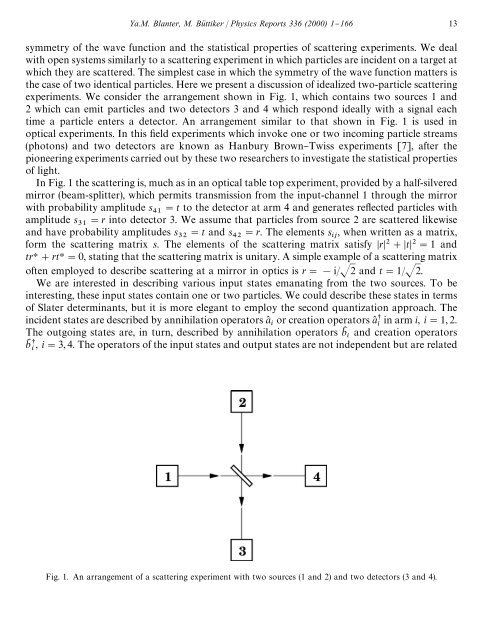shot noise in mesoscopic conductors - Low Temperature Laboratory
shot noise in mesoscopic conductors - Low Temperature Laboratory
shot noise in mesoscopic conductors - Low Temperature Laboratory
Create successful ePaper yourself
Turn your PDF publications into a flip-book with our unique Google optimized e-Paper software.
Ya.M. Blanter, M. Bu( ttiker / Physics Reports 336 (2000) 1}166 13<br />
symmetry of the wave function and the statistical properties of scatter<strong>in</strong>g experiments. We deal<br />
with open systems similarly to a scatter<strong>in</strong>g experiment <strong>in</strong> which particles are <strong>in</strong>cident on a target at<br />
which they are scattered. The simplest case <strong>in</strong> which the symmetry of the wave function matters is<br />
the case of two identical particles. Here we present a discussion of idealized two-particle scatter<strong>in</strong>g<br />
experiments. We consider the arrangement shown <strong>in</strong> Fig. 1, which conta<strong>in</strong>s two sources 1 and<br />
2 which can emit particles and two detectors 3 and 4 which respond ideally with a signal each<br />
time a particle enters a detector. An arrangement similar to that shown <strong>in</strong> Fig. 1 is used <strong>in</strong><br />
optical experiments. In this "eld experiments which <strong>in</strong>voke one or two <strong>in</strong>com<strong>in</strong>g particle streams<br />
(photons) and two detectors are known as Hanbury Brown}Twiss experiments [7], after the<br />
pioneer<strong>in</strong>g experiments carried out by these two researchers to <strong>in</strong>vestigate the statistical properties<br />
of light.<br />
In Fig. 1 the scatter<strong>in</strong>g is, much as <strong>in</strong> an optical table top experiment, provided by a half-silvered<br />
mirror (beam-splitter), which permits transmission from the <strong>in</strong>put-channel 1 through the mirror<br />
with probability amplitude s "t to the detector at arm 4 and generates re#ected particles with<br />
amplitude s "r <strong>in</strong>to detector 3. We assume that particles from source 2 are scattered likewise<br />
and have probability amplitudes s "t and s "r. The elements s , when written as a matrix,<br />
form the scatter<strong>in</strong>g matrix s. The elements of the scatter<strong>in</strong>g matrix satisfy r#t"1 and<br />
trH#rtH"0, stat<strong>in</strong>g that the scatter<strong>in</strong>g matrix is unitary. A simple example of a scatter<strong>in</strong>g matrix<br />
often employed to describe scatter<strong>in</strong>g at a mirror <strong>in</strong> optics is r"!i/2 and t"1/2.<br />
We are <strong>in</strong>terested <strong>in</strong> describ<strong>in</strong>g various <strong>in</strong>put states emanat<strong>in</strong>g from the two sources. To be<br />
<strong>in</strong>terest<strong>in</strong>g, these <strong>in</strong>put states conta<strong>in</strong> one or two particles. We could describe these states <strong>in</strong> terms<br />
of Slater determ<strong>in</strong>ants, but it is more elegant to employ the second quantization approach. The<br />
<strong>in</strong>cident states are described by annihilation operators a( or creation operators a( <strong>in</strong> arm i, i"1, 2.<br />
The outgo<strong>in</strong>g states are, <strong>in</strong> turn, described by annihilation operators bK and creation operators<br />
bK , i"3, 4. The operators of the <strong>in</strong>put states and output states are not <strong>in</strong>dependent but are related<br />
Fig. 1. An arrangement of a scatter<strong>in</strong>g experiment with two sources (1 and 2) and two detectors (3 and 4).
















